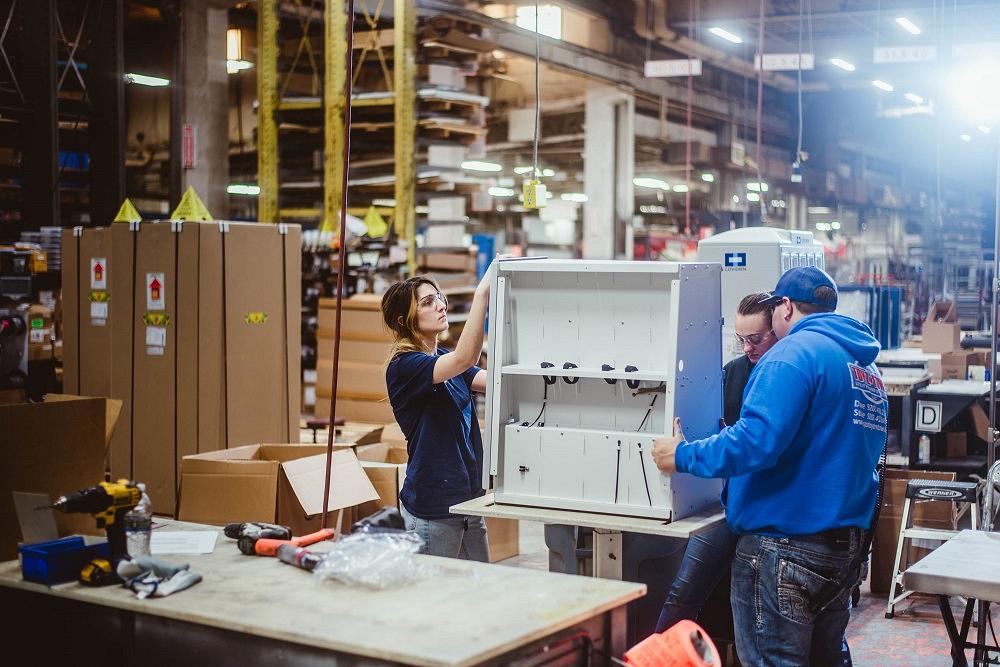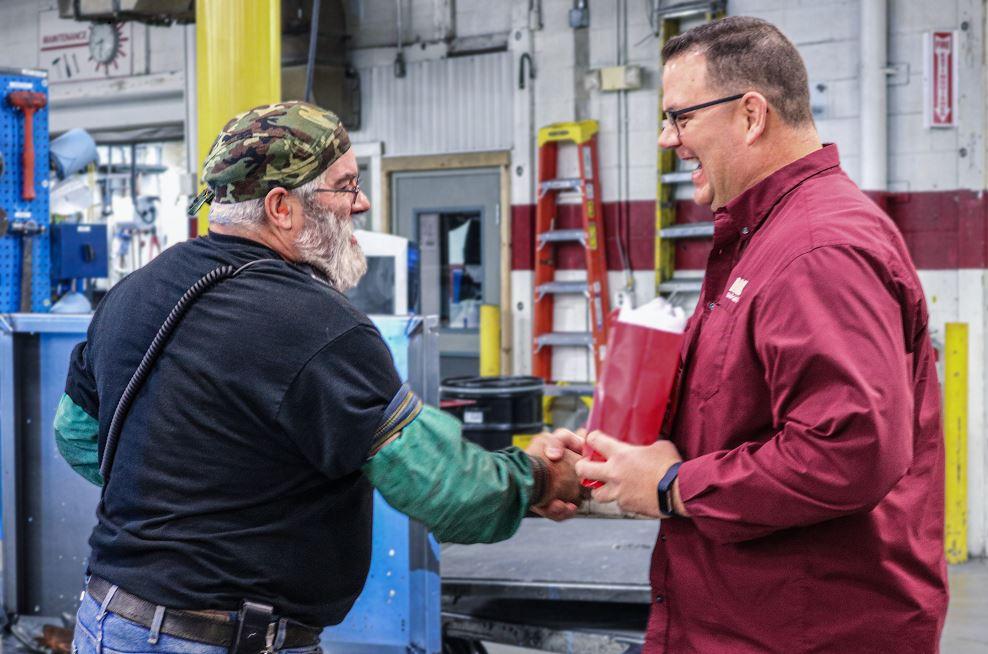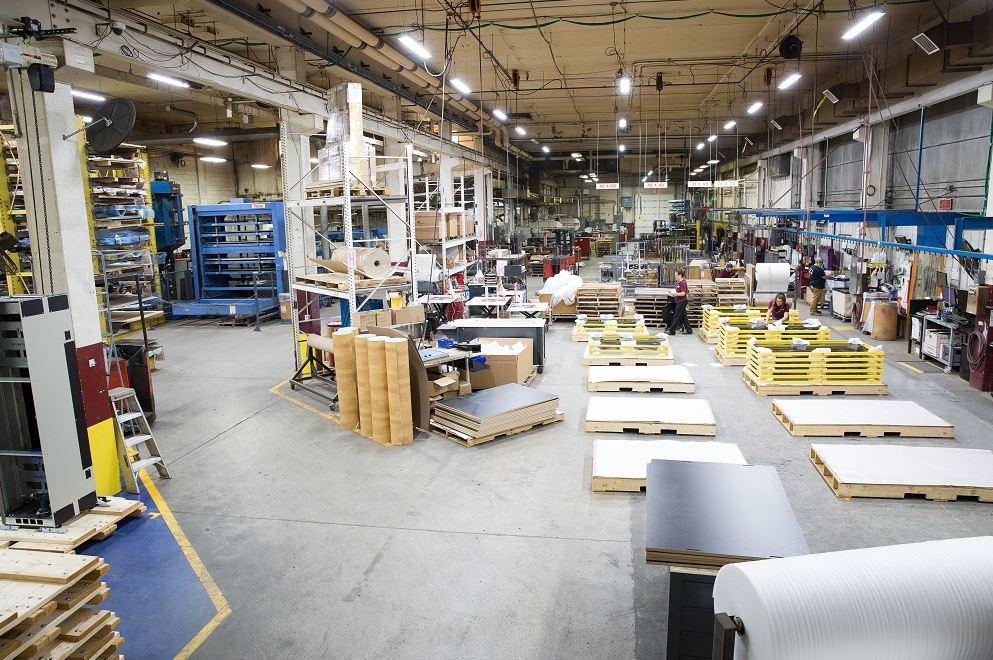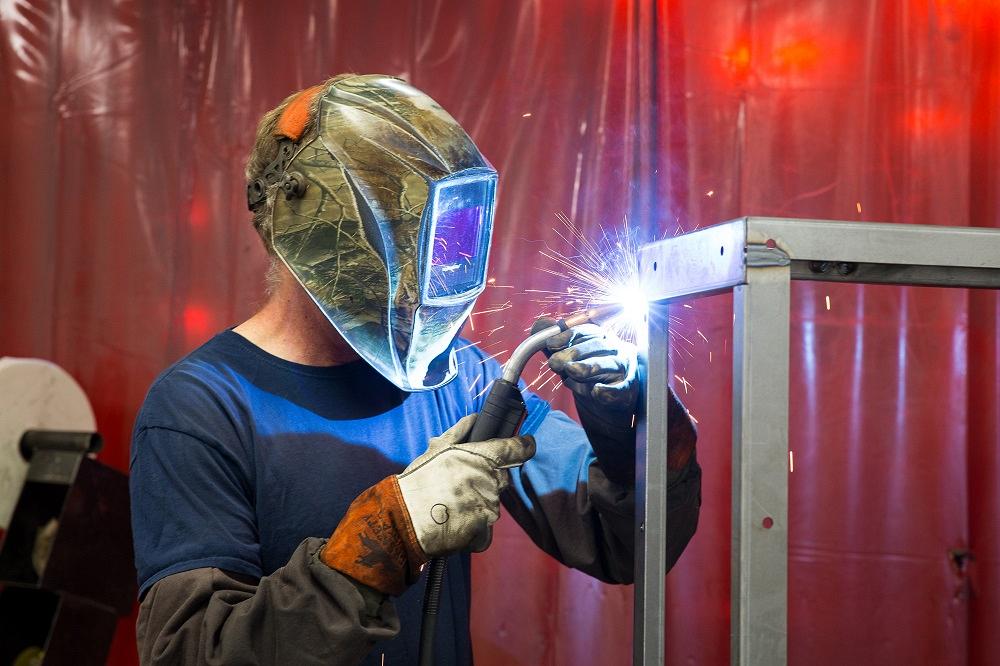Editor-in-Chief
- FMA
- The Fabricator
- FABTECH
- Canadian Metalworking
Categories
- Additive Manufacturing
- Aluminum Welding
- Arc Welding
- Assembly and Joining
- Automation and Robotics
- Bending and Forming
- Consumables
- Cutting and Weld Prep
- Electric Vehicles
- En Español
- Finishing
- Hydroforming
- Laser Cutting
- Laser Welding
- Machining
- Manufacturing Software
- Materials Handling
- Metals/Materials
- Oxyfuel Cutting
- Plasma Cutting
- Power Tools
- Punching and Other Holemaking
- Roll Forming
- Safety
- Sawing
- Shearing
- Shop Management
- Testing and Measuring
- Tube and Pipe Fabrication
- Tube and Pipe Production
- Waterjet Cutting
Industry Directory
Webcasts
Podcasts
FAB 40
Advertise
Subscribe
Account Login
Search
How to run a manufacturing company with two distinct customer bases
Wisconsin metal fabrication shop HUI Mfg. puts the power in the hands of those who make the parts
- By Dan Davis
- July 13, 2022
- Article
- Shop Management

Members of HUI Mfg.’s assembly team assemble a medical device platform before shipping to an OEM customer. Images: HUI Mfg.
A metal fabricating company having multiple customers in one sector, such as agriculture or construction, is the reality of the business. These customers require parts made of the same materials and have similar quality expectations. A metal fabricating company serving two distinct and totally different sectors is a bit more unusual because it’s not as easy to pull off.
The origin stories of these types of operations are easy to understand. Say a metal fabricating company that has been successful serving an industry sector like retail displays but needs to diversify because retailers aren’t building as many brick-and-mortar locations, and that same company wants to launch a contract manufacturing business. Maybe a job shop finds success fabricating a particular product for a customer, and then others in that industry want something similar, ultimately creating a new business opportunity that turns out to be significantly different from the shop’s core industrial business.
HUI Mfg., Kiel, Wis., did the latter in 2001. It made the decision to pursue the medical cart business in a bid to diversify the customer base and to find customers that required expertise to bring high-concept and high-tolerance designs to life—the complex work that other shops might not want to deal with. It also helped that someone in the front office had worked in that industry and could provide a very valuable contact.
Anyone can get a contact name, however. It’s what follows after reaching out to the contact that really counts. HUI Mfg. has done well serving this market, with medical carts now representing about 30% of its $17 million in annual sales. As an example of the company’s work in this area, HUI produced a cart with a ventilator hood system for use in highly infectious environments, a necessary response medical professionals needed in the fight against COVID-19.
The transition to serving the medical community had its share of challenges, according to Kurt Bell, the company’s president and CEO. HUI employees had to shift their mindset from fabricating other people’s designs to providing their own design knowledge, material expertise, and ideas about manufacturability as they became an integral part of another company’s product development function. Bell said early discussions with some medical carts customers involved design cues such as “needs to make the patient feel safe” or “let’s make it sexy,” something that never would make its way into conversations with its industrial customers.
How did HUI make that successful transition into becoming a 20-year supplier of medical carts? It involved a lot of change, starting in the 1990s.
History of HUI
The story of HUI begins with Albert Deibele Sr., a German immigrant who was an electrical engineer by trade but became much more after moving to Wisconsin. In 1933 he opened a business that provided refrigeration, radio, electrical wiring, plumbing, and sheet metal services as part of a full-service retail concept. As the years passed, however, Household Utilities Inc. (HUI) pulled away from its original residential focus.
Albert Deibele Sr.’s sons, Albert Jr. and Charles, got involved in the business and ultimately took over for their father, which helped to speed up the company’s evolution into a metal fabricator. What started out as an early Radio Shack/Best Buy retail concept evolved into an electrical contracting business, then into general contracting, and finally into an HVAC shop with metal fabricating capabilities.
Albert Jr., the company president, ran the HVAC business. Charles, the vice president, launched a production division that specialized in custom metal fabrication as well as producing product lines that were sold by distributors nationwide.
Following the death of Albert Jr. in 1989, the company was left in Charles’ hands. At that time, HUI shifted its focus away from the HVAC business and committed all of its energies to being a provider of metal fabricating services. The transition of Household Utilities Inc. to HUI Mfg. was complete.

HUI Mfg. owner and CEO Kurt Bell (right) shakes hands with 34-year veteran employee Wayne Pritzl. Bell began his journey at HUI in 1993 as a scheduler before becoming president and later purchasing the company from the Deibele family.
Bell joined HUI in 1993 as a scheduler. He had worked for a larger business consultancy and realized he didn’t want to do that the rest of his life. Working at a metal fabricating company gave him a buzz that reminded him of his college football days at Indiana State. The business was competitive. There were tight cycles. It was complex and required teamwork. It was a good fit.
But HUI still had a lot of growing to do to achieve revenue growth and create more career opportunities for its employees.
“It was just your normal entrepreneurial company. It didn’t have a lot of formal processes and rules. It did whatever was needed to survive,” Bell recalled.
In the mid-1990s, the owner decided to buy out some remaining family members who were involved in the business. At that point, he promised that HUI would never be a family business again. It would be a privately held company with leaders that make decisions based on what’s good for employees and customers, not those who happen to be related to the owner.
Shortly thereafter Bell was offered the opportunity to be the company’s director of operations. At the time HUI had about $8 million in annual sales, but Bell said he knew that it needed to instill formal processes and invest in management training if the company were to grow.
“We were going to take HUI from a place that really cares about people to a place that really cares about people and can perform,” Bell said.
The key was finding common ground with the owner. Bell initially thought he and his boss saw the business from two diametrically opposed vantage points: The owner cared about the people, but not so much about the revenue, and Bell was all about the business and not the people. After some heartfelt conversations, Bell and the owner found common ground.
“It turns out we both had the same passion for people growing,” he said.
Early on Bell recognized that having a plan would be good for him and the company. It would provide HUI a path to follow so that it could grow, and Bell then could start making decisions, knowing what the ultimate goal was.
A look at the changing metal fabricating landscape and nearby competitors in southeast Wisconsin revealed that HUI couldn’t compete against what Bell called the “big boys.” These shops were all chasing high-volume jobs, which HUI was not really set up to pursue. That’s when HUI formulated a strategy to counter what the competitors were doing. The company was going to pursue low-volume jobs with short lead times that were complex in nature.
“We ended up calling it the Statue of Liberty strategy: Give us the stuff that nobody else really wants,” Bell said.
By 1996 Bell had moved into the role of company president. The strategy to take on more complicated work proved prescient as plenty of high-volume metal fabricating work was shifted overseas in the late 1990s and early 2000s. The next step in the strategy was to offer more value-added work to customers.
HUI had talented engineers that could offer up design expertise that might not exist at some OEM companies, and the company never hesitated to invest in new manufacturing technology, like the first laser/punch combination machine or, later, a powder coating line. Bell said that early on, HUI won some light assembly work, such as powder coating parts or adding a door to a fabricated enclosure, but for the most part, industrial companies were hesitant to reward such projects to a company known for just supply parts. “We were the laser, form, and maybe paint people,” he said.
The business growth strategy needed to evolve, so the management team decided to focus a few specific industry segments: telecommunications, computers, and medical. Around that time a major telecommunications plant closed in Mayville, Wis., and Dell Computers had begun to consolidate its manufacturing efforts in Texas. That left the focus on the medical industry.
“Somebody eventually let us make a medical cart, and we kept making them. We expanded and happened to time the market pretty well,” Bell said. “We took what we were doing in the medical field and showed it to our industrial customers. They said, ‘Well, if we knew you could do that, we’d have you do this stuff before.’”
That was the beginning of real growth for HUI, but that’s just part of the story. Here’s how the company has been able to serve two distinctly different customer segments under the same roof.
Empower the Employees
In 1998 HUI made a commitment to start a lean manufacturing journey. The catch, however, was that lean was still in the early adoption phase for most manufacturers. That translated into lean principles geared toward high-volume, low-mix environments, something that wasn’t going to do HUI any good.
“The consultants wrote about assembly lines and fixed SKUs,” Bell recalled. “We failed miserably because we tried to do what they did. It didn’t apply to us.
“We had to take the concept and make it apply it us.”
Bell said he struggled early on to understand why certain continuous improvement ideas wouldn’t register with employees. A reorganization of a work area or an adjustment to process flow with very evident benefits would be met with resistance from employees involved with the targeted area for improvement.

HUI Mfg.’s 80,000-sq.-ft. facility houses four fabrication cells, a 1,160-ft. monorail paint line with two paint booths, an assembly area, and a warehouse. The company prides itself on the cleanliness of the shop floor, citing employee comfort as a high priority.
Then one day he realized the debate wasn’t about whether an idea was good or not. The problem was the employees didn’t have any say in the decision-making process.
“I thought, if somebody came into my house and rearranged my family room, I wouldn’t tolerate it,” Bell said. “Even if it were better, I wouldn’t tolerate it.”
HUI was missing the group dynamics piece. If people were to accept and thrive in an ever-changing work environment, they needed to be empowered to help shape that future.
“We think the secret is that you have to go back to your culture to fix your lean program,” Bell said.
That started by treating employees like the adults they were. They got to provide input. They also were held accountable. Successes were celebrated, and shortcomings were addressed, sometimes in uncomfortable conversations.
Bell said a lot of training has been dedicated to teaching people to be able to engage with each other without it turning emotional. What are the ways that criticism can be delivered—and received—so that the challenge can be addressed, and hurt feelings aren’t part of the mix? It’s all about adults having real-world discussions about important matters without the aggression or jealousy that can turn conversations sideways.
“When you have this care for people and this lean approach, then it becomes evident that teams can achieve greatness,” Bell said. HUI wasn’t going to be an organization dominated by managers looking to make their bosses look good; it was going to be a place where employees were empowered to make the right moves, and if they didn’t, their co-workers were going to be there to pick them up and move forward.
Learn the Language
When HUI first jumped into the medical cart business, Bell joined a salesperson in a meeting with a medical device company where they talked about the need for the cart they were discussing to be a symbol of protection. Because the technology sitting on top of the cart was used in medical emergencies in post-pregnancy situations, the customer said the cart had to make the mother “feel safe.”
Bell said he put on his poker face, exited the meeting, got in the car, and wondered how that directive translated into a product design. “We had to find people that understood that language and could help us,” he said.
HUI worked with contract designers who had experience in the medical space, and they didn’t hesitate when getting feedback from the medical customers. They understood the lingo of the business-to-consumer world and could translate that into design features that registered with the clients. It was much more than just making a part that met customer specifications.
“That’s their brand. The cart is a platform not only for their technology, but for their brand,” said Mary Kahler, HUI’s strategic marketing manager. “It’s their interface with the end user. That’s so important, and it’s much different than opening an electrical cabinet. The medical practitioner at a clinic or a hospital has to work with this thing every day, so it has to be the right fit.”
Setting Up the Front Office
With the medical cart business ramping up, HUI recognized that it needed to get its front office to accommodate the very different dynamics. The medical cart side of the business would have less volume and much more R&D effort than the industrial side of the business. The industrial business was much more formulaic: managing materials, hammering out the price, finalizing the prints, and making the parts.
Bell said that HUI separated engineering, sales, and customer service. Each would immerse itself in a business that was more different than similar.
Aiding this effort was a front office dominated by people that came from the shop floor. Because of their lean thinking and ability to question and comment on processes, those with shop floor experience were able to troubleshoot the still-evolving medical cart design and fabrication process. They had set up workcells on the floor before, so they asked the right questions. What was the product? What are the work centers involved? What’s the sequencing of the work centers? What gaps exist where additional training is needed?
Provide Ongoing Training
Training has been a part of HUI since the late 1990s. At the time, HUI was looking at ways to bolster their welding ranks. They had been hiring people based strictly on skill, but soon realized that the company might be better off hiring those who had a good attitude and then providing welding training.
HUI constructed a training area and named one of its best welders as the lead trainer. (The welder also happened to be married to a teacher, who proved very influential in the way he interacted with his welding students.)
That same spirit exists today, as the company of 130 employees has two full-time training professionals and about seven others who are involved in training efforts on a part-time basis. “What we’ve figured out is that training is really a way of saying ‘I care about you’ to our employees,” Bell said.
Kahler added that the trainers are instrumental in filling talent gaps and helping to incorporate new technology on the shop floor. That most recently has been on display as HUI installed a TRUMPF TruBend 5130 press brake in February. (The company already has added two new press brakes and expected a fourth to be added toward the end of the second quarter.) A trainer acts as the champion of the new bending tool, learning how it works, creating training materials, and figuring out the best way to operate the machine in conjunction with how things flow on the shop floor. For instance, operators won’t need to program the jobs because that will be done offline, reducing the time between jobs and making it possible to cater to short runs.
Bell said the new press brakes require significantly less training time than the older generation of press brakes, which in some cases might require several months of training for a new employee.
“When we put you on a new machine, in two weeks you’re going to say that you can make parts,” Bell said. “So that’s our emphasis on technology: It needs to be easy to get somebody up and running on it.”
“All of this supports retention over time,” Kahler added. “If people feel like they know what they’re doing and that they’re contributing, they feel successful.”
Continue to Grow
When asked about what the near future holds for HUI, Bell provides two different answers. The “business answer,” as Bell called it, is that he’d love to see the company reach $32 million in annual sales and keep adding more automation to create the capacity to work toward that growth goal. The other answer, however, reflects more on what’s been built at HUI over the years.
“Where I’d like to see it go is I would like people to believe that they’re better outside of work because they work here,” he said.
It might be a compliment on how they approached a potential volatile issue with a sibling. It might be a successful resolution to a disciplinary case with a child. Bell said he’d like to see the skills that have helped his teammates tame the chaos associated with contract manufacturing help them stay on top of all the challenges that life throws at them.
About the Author

Dan Davis
2135 Point Blvd.
Elgin, IL 60123
815-227-8281
Dan Davis is editor-in-chief of The Fabricator, the industry's most widely circulated metal fabricating magazine, and its sister publications, The Tube & Pipe Journal and The Welder. He has been with the publications since April 2002.
subscribe now

The Fabricator is North America's leading magazine for the metal forming and fabricating industry. The magazine delivers the news, technical articles, and case histories that enable fabricators to do their jobs more efficiently. The Fabricator has served the industry since 1970.
start your free subscription- Stay connected from anywhere

Easily access valuable industry resources now with full access to the digital edition of The Fabricator.

Easily access valuable industry resources now with full access to the digital edition of The Welder.

Easily access valuable industry resources now with full access to the digital edition of The Tube and Pipe Journal.
- Podcasting
- Podcast:
- The Fabricator Podcast
- Published:
- 04/16/2024
- Running Time:
- 63:29
In this episode of The Fabricator Podcast, Caleb Chamberlain, co-founder and CEO of OSH Cut, discusses his company’s...
- Trending Articles
Capturing, recording equipment inspection data for FMEA

Tips for creating sheet metal tubes with perforations

Are two heads better than one in fiber laser cutting?

Supporting the metal fabricating industry through FMA

Omco Solar opens second Alabama manufacturing facility

- Industry Events
16th Annual Safety Conference
- April 30 - May 1, 2024
- Elgin,
Pipe and Tube Conference
- May 21 - 22, 2024
- Omaha, NE
World-Class Roll Forming Workshop
- June 5 - 6, 2024
- Louisville, KY
Advanced Laser Application Workshop
- June 25 - 27, 2024
- Novi, MI



























